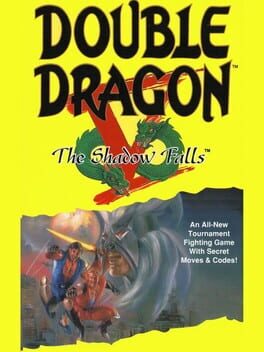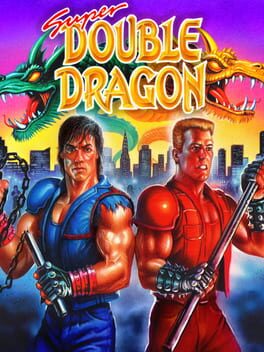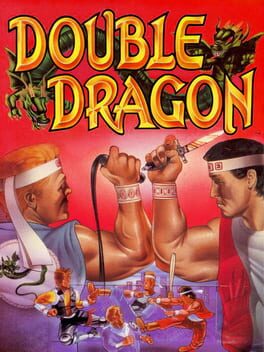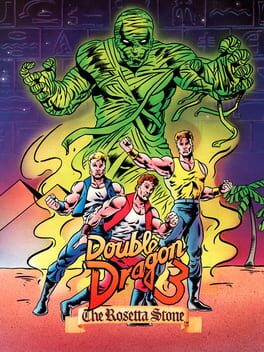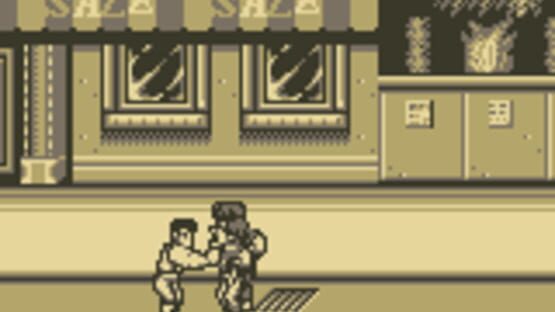

Double Dragon II is a side-scrolling developed and released for the Game Boy and unrelated to Double Dragon II: The Revenge. The player takes control of martial artist Billy Lee, who is being hunted down by an organization called the "Scorpions" for murdering one of its members. The objective of the game is to fight off the members of the Scorpions and confront the true culprit, a rival martial artist named Anderson. A second player can now join in anytime via the use of a Game Link Cable, taking control of Billy's brother, Jimmy. The combat system is simpler compared to previous Double Dragon games, including the first Game Boy game. The player can perform a series of punches or a kick on most enemies, followed by straight punch or a high kick that knocks the enemy to the floor. Pressing the A and B buttons simultaneously will cause the player to kneel. While kneeling, pressing either button will cause the player to perform an aerial uppercut. Instead of the hair grab from previous games, the player will do a collar grab (similar to Renegade), in which the player can repeatedly punch his opponent in the face or push them to the ground. While standing near a fallen enemy, a jumping knee drop can be performed. Despite the presence of armed enemies, the player cannot disarm them and pick up their weapons like in other games in the series. The game is composed of three missions, spread across ten stages. The first two missions each consist of four stages that follows a basic structure: the player fight their way through a street until reaching the boss. This is followed by a subway platform, a fight inside a subway car, and the destination platform, where the player confronts another boss. The final mission, composed of only two stages, starts at the streets again, but this time the player must fight his way to the entrance of the Scorpions headquarters. Once inside the building, the player fight their way through a series of floors, including an area where all the previous bosses appear, until reaching the top floor where Anderson awaits. The game has three difficulty settings, but the Easy setting only allows the first mission to be played.
Also in series
Reviews View More
But anyways, the game did release, and after playing it, I would say that it is pretty good at what it tries to do, being an alright handheld beat-’em-up, while also providing an enjoyable enough time. Would I consider it as good as the other two Double Dragon IIs? Not even close, with the NES Double Dragon II easily being the best with enough variety in gameplay and content, but for what it is worth, this game still provides enough fun for at least enough time that your morbid curiosity could allow you to have with the game.
The story is actually more complex than just “save girl” this time around, but that could just be because it is a Kunio-kun game in disguise, the graphics are Game Boy graphics, but the sprites are pretty faithful to the other Double Dragon games, so at least I can recognize it as Double Dragon, the music is pretty solid overall, with plenty of tracks throughout, the control is what you would expect from a game like this, and they are pretty easy to pick up and get a feel for, and the gameplay is about what you would expect, while also being simple and fun enough to be a good way to kill some time.
The game works exactly how you would expect a handheld Double Dragon to work, where you move throughout several stages featuring different locations, defeating a great handful of goons and bosses, and… that is literally about it. Yeah, it is extremely bare bones, even compared to previous games, where features such as weapons are completely removed, which really sucks, and it makes the game feel soulless when compared to past titles. Then again, it is a Kunio-kun game at its core, and at this point, I have only played one other game in that series, that being Renegade, and in terms of similarities, this game feels much more true to that game, so I guess I can give it credit for accomplishing that.
Not to mention, just like with Renegade, you are given quite a number of moves to pull off in order to take out enemies, such as a punch, a kick, an uppercut, and even a takedown move when an enemy is lying on the floor. This does provide some variety to the combat, even if this variety wears out pretty quickly, and in terms of enemies, there is also some variety here, where you get your standard thugs, whip wielders and knife handlers, and then you get shit like in the last stage where you have Jason fucking Voorhees trying to take you down. Yeah, that kinda threw me off guard first time seeing it, and it was a little funny to see.
However, the game does have problems of its own, aside from the lack of interesting gameplay features. For one thing, you execute moves reeeeeeeeeeally slowly. It isn’t too slow, but compared to the speed at which you could beat up an enemy in the NES Double Dragon, it is quite the downgrade. I guess this was like this due to the Game Boy’s limitations, but even still, it is a letdown. And secondly, the final stage can be a pain in the ass. Yeah, it is appropriate for the final stage, but it starts out fine enough, with you taking on regular enemies, but as you move up through the building, you have to refight multiple bosses at once, and trust me, it can be pretty annoying, especially when some of these bosses have guns.
I will give credit where credit is due though. Like I mentioned earlier, the story is better than anything we have seen in the Double Dragon/Kunio-kun series at this point, with multiple cutscenes and dialogue boxes detailing things that are happening. Sure, this isn’t on the same level that Ninja Gaiden is on, but the effort is appreciated. Having said that, it can be a little confusing, given how there are plot elements that aren’t explained all too well, and the dialogue reads like it was written by an 8-year old, which can be pretty distracting at the couple points it is featured.
Overall, while it is somewhat of a step up in terms of what was present in previous Double Dragon and Kunio-kun games, it is also more of a step down in terms of gameplay, length, and its purpose of even existing at all. If I were to rank it among the other Double Dragon IIs (which I don’t want to, but blame the devs for making too many of them), I would say it is middle of the road, with the NES game being the best and the arcade game being the worst. But either way, now that we have gotten all that out of the way, we can now FINALLY move on to the third game!.......... when I feel like it.
Game #217
The combat is fine with a surprising amount of moves (two-button uppercut, ground finisher, and a grab in addition to the standard punches and kicks) but every animation is agonizingly slow, making you feel like you're fighting in knee deep mud. Thankfully, the enemies aren't any faster with their (sometimes quite impressive, actually) attack animations, so once you account for the general slow speed of combat, it becomes second nature. Actually, most of it quickly gets like that, because all the enemies (including every boss) require essentially the same rudimentary strategy to defeat, so as soon as you get that standard approach down, it's repeat all the way to the end of the game. And with the relatively stock enemies^ and levels (some of the latter of which are repeated, shamefully) that means a pretty boring, long run. At least it's easy.
They have such a solid framework here that it's a shame they didn't do anything more to spice it up. It really wouldn't have taken much. But it does deserve some minor praise for being a complete and playable brawler. I wonder if the JPN Kunio-Kun version is any more interesting.
^The level bosses in this game follow the age-old, logical progression of Boxer -> Jason Voorhees -> Ninja Master -> Italian guy

